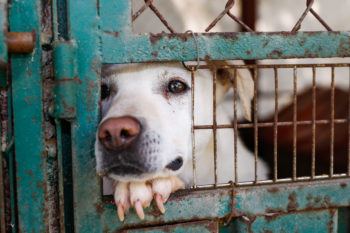Animal Abuse

A tragic, yet not uncommon occurrence among pet owners is that of animal abuse. It is hard for many of us to believe how someone could inflict harm on such loving and devoted creatures, but it happens. More often than not, it is the stray and wandering dogs that have been abused. We must be aware of how to take the right precautions when welcoming a pet into the family, who may have been abused. You want to make sure the animal knows it is now in a safe and loving home where it will be cared for properly.
“Some warning signs of abuse and neglect can lead to behavioral issues of aggression, barking, destructive behavior, disobedient behavior, and inappropriate elimination that may have lead to owner punishment” said Dr. M.A. Crist, Clinical Assistant Professor at Texas A&M College of Veterinary Medicine. “Conditions that are suggestive of animal abuse are animal welfare issues such as a poor physical state, abandonment, the collar grown into the neck, matted coat, ectoparasite infestation, and no veterinary care. Physical injuries such as bruising, eye injuries, fractures, repetitive lesions or injuries, internal injuries, gunshot wounds, drugs, poisons and drowning are also evidence of abuse. Environmental concerns such as the large numbers of animals, overcrowding with dead animals present and human welfare issues with the owner not able to afford to feed a pet, fighting the animal, or a ritualistic sacrifice are other conditions that an animal may be a victim of abuse.”
Oftentimes, if an animal is shy, it is difficult to tell whether or not they have been abused in the past. Is it shyness, or fear caused by the abuse?
“Most of the times it is fear triggered from the original abuse” said Crist. “Correcting this behavior is not always easy but rehabilitation can occur. Patience and time with the pet will take pressure off the pet and help speed the healing process. With a severe fear that was caused by abuse and causes the dog to become injurious to themselves, a veterinary behavior specialist is recommended. This specialist can prescribe some behavior modification medication to deal with the fear if needed. If this fear causes the dog to react aggressively toward people, then a behaviorist will be able to address this issue as well.”
If you have adopted a stray who you believe might have been a victim of abuse, there are several things you can do to ensure whether or not abuse has occurred.
“Have your veterinarian perform a thorough examination on the pet. Interestingly enough not all pets who behave as they have been abused were abused” said Crist. “Sometimes the public tends to associate a withdrawal behavior to sudden movement as an abused animal and this may not be the case. Veterinarians have to be sensitive to the possibility that the abused pet could be the victim of owner-induced abuse or neglect. We have to regard these concerns for the welfare of the patient but as well as other animals in the household. Veterinarians also have to be sensitive to the issue that the client might be a victim of an abusive relationship and that providing veterinary and foster care for the pet may provide an escape from the abusive relationship.”
The veterinarian will document all findings on the thorough physical examination.
“The pet’s mental status and initial behavior are evaluated and monitored” said Crist. “Most often animals that are depressed initially often exhibit behavior changes as their physical and emotional status improves. Laboratory tests and whole body radiographs are performed. Pictures or videos of any wounds, traumatic injuries, neglect, or collars or leashes embedded in the neck are gathered for evidence. All of these elements can make a powerful case for animal cruelty.”
Abused pets may have issues like food guarding, stress around strangers, phobias of loud noises, or fear of children, if they have been abused by them. There are several treatment options that can help your pet overcome these fears, or at least to make him feel safe and secure whenever these situations occur.
“If your pet has a food guarding issue, you might consider not having a buffet of food” said Crist. “It might be recommended to keep the pet in another room or place a baby gate to separate the pet with an interactive toy or another canine companion. Holidays usually bring guests and if your pet gets stressed with strangers it might be beneficial to board your pet. If your pet will not tolerate a boarding facility, as some abused pets do not do well at these types of facilities, ask a family friend that the pet has a good relationship with to babysit. Phobias of loud noises or thunderstorms are best treated with repeated medications prescribed by an animal behaviorist with short acting anti-anxiety medication. Do not put a fearful dog in a backyard because it is not protected from other humans or children entering the yard and setting up an unpredictable situation. Placing a dog in a crate can be stressful and if they are not used to it or it gives them a physical boundary they have to defend it may make matters worse for an abused patient.”
Tragically, pet abuse happens every single day to sweet and harmless animals, so the need to recognize and document animal abuse is important to reduce animal cruelty.
Media contact: Pet Talk, Texas A&M College of Veterinary Medicine & Biomedical Sciences.





